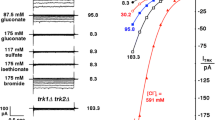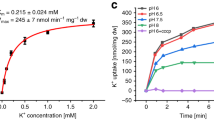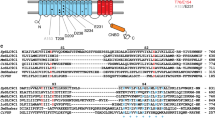Abstract
Patch clamp studies of the potassium-transport proteins TRK1,2 in Saccharomyces cerevisiae have revealed large chloride efflux currents: at clamp voltages negative to −100 mV, and intracellular chloride concentrations >10 mM (J. Membr. Biol. 198:177, 2004). Stationary-state current-voltage analysis led to an in-series two-barrier model for chloride activation: the lower barrier (α) being 10–13 kcal/mol located ∼30% into the membrane from the cytoplasmic surface; and the higher one (β) being 12–16 kcal/mol located at the outer surface. Measurements carried out with lyotrophic anions and osmoprotective solutes have now demonstrated the following new properties: (1) selectivity for highly permeant anions changes with extracellular pH; at pHo = 5.5: I− ≈ Br− > Cl− > SCN− > NO −3 , and at pHo 7.5: I− ≈ Br− > SCN− > NO −3 > Cl−. (2) NO −2 acts like “superchoride”, possibly enhancing the channel’s intrinsic permeability to Cl−. (3) SCN− and NO −3 block chloride permeability. (4) The order of selectivity for several slightly permeant anions (at pHo = 5.5 only) is formate > gluconate > acetate >> phosphate−1. (5) All anion conductances are modulated (choked) by osmoprotective solutes. (6) The data and descriptive two-barrier model evoke a hypothetical structure (Biophys. J. 77:789, 1999) consisting of an intramembrane homotetramer of fungal TRK molecules, arrayed radially around a central cluster of four single helices (TM7) from each monomer. (7) That tetrameric cluster would resemble the hydrophobic core of (pentameric) ligand-gated ion channels, and would suggest voltage-modulated hydrophobic gating to underlie anion permeation.









Similar content being viewed by others
References
Arriza JL, Ellasof S, Kavanaugh MP, Amara SG (1997) Excitatory amino acid transporter 5, a retinal glutamate transporter coupled to a chloride conductance. Proc Natl Acad Sci USA 94:4155–4160
Back JF, Oakenfull D, Smith MB (1979) Increased thermal stability of proteins in the presence of sugars and polyols. Biochem 18:5191–5196
Beckstein O, Biggin PC, Sansom MSP (2001) A hydrophobic gating mechanism for nanopores. J Phys Chem B 105:12902–12905
Beckstein O, Sansom MSP (2003) Liquid-vapor oscillations of water in hydrophobic nanopores. Proc Nat Acad Sci USA 100:7063–7068
Beckstein O, Sansom MSP (2006) A hydrophobic gate in an ion channel: the closed state of nicotinic acetylcholine receptor. Phys Biol 3:147–159
Beilby MJ (1986) Potassium channels and different states of Chara plasmalemma. J Membr Biol 89:241–249
Bertl A, Bihler H, Kettner C, Slayman CL (1998) Electrophysiology in the eukaryotic model cell Saccharomyces cerevisiae. Eur J Physiol 436:999–1013
Bertrand D, Ballivet M, Rungger D (1990) Activation and blocking of neuronal nicotinic acetylcholine receptor reconstituted in Xenopus ocytes. Proc Natl Acad Sci USA 87:1993–1997
Bihler H, Gaber RF, Slayman CL, Bertl A (1999) The presumed potassium carrier Trk2p in Saccharomyces cerevisiae determines an H+-dependent, K+-independent current. FEBS Lett 447:115–120
Blatt MR, Slayman CL (1983) KCl leakage from microelectrodes and its impact on the membrane parameters of a non-excitable cell. J Membr Biol 72:223–234
Bocquet N, Nury H, Baaden M, Le Poupon C, Changeux J-P, Delarue M, Corringer P-J (2009) X-ray structure of a pentameric ligand-gated ion channel in an apparently open conformation. Nature 457:111–114
Bormann J, Hamill OP, Sakmann B (1987) Mechanism of anion permeation through channels gated by glycine and γ-aminobutyric acid in mouse cultured spinal neurons. J Physiol 385:243–286
Caldas T, Demont-Caulet N, Ghazi A, Richarme G (1999) Thermoprotection by glycine betaine and choline. Microbiology 145:2543–2548
Cao Y, Jin X, Huang H, Derebe MG, Levin EJ, Kabaleeswaran V, Pan Y, Punta M, Love J, Weng J, Quick M, Ye S, Kloss B, Bruni R, Martinez-Hackert E, Hendrickson WA, Rost B, Javitch JA, Rajashankar KR, Jiang Y, Zhou M (2011) Crystal structure of a potassium ion transporter, TrkH. Nature 471:336–341.
Cássio F, Leão C (1993) A comparative study on the transort of L(−)malic acid and other short-chain carboxylic acids in the yeast Candida utilis: evidence for a general organic acid permease. Yeast 9:743–752
Chen T-Y (2005) Structure and function of ClC channels. Ann Rev Physiol 67:809–839
Collins KD, Wasabaugh MW (1985) The Hofmeister effect and the behaviour of water at interfaces. Quart Rev Biophys 18:323–422
Coster HGL (1968) The role of pH in the punch-through effect in the electrical characteristics of Chara australis. Aust J Biol Sci 22:365–374
Crowe JH, Hoekstra FA, Crowe LM (1992) Anhydrobiosis. Ann Rev Physiol 54:579–599
Dani JA, Sanchez JA, Hille B (1983) Lyotropic anions: Na channel gating and Ca electrode response. J Gen Physiol 81:255–281
Demidchik V, Bowen HC, Maathuis FJM, Shabala SN, Tester MA, White PJ, Davies JM (2002) Arabidopsis thaliana root non-selective cation channels mediate calcium uptake and are involved in growth. Plant J 32:799–808
Dräber S, Schultze R, Hansen U-P (1991) Patch-clamp studies on the anomalous mole fraction effect of the K+ channel in cytoplasmic droplets of Nitella: an attempt to distinguish between a multi-ion single-file pore and an enzynme kinetic model with lazy state. J Membr Biol 123:183–190
Durell SR, Guy HR (1999) Structural models of the KtrB, TrkH, and Trk1,2 symporters, based on the crystal structure of the KcsA K+ channel. Biophys J 77:789–807
Durell SR, Hao Y, Nakamura T, Bakker EP, Guy HR (1999) Evolutionary relationship between K+ channels and symporters. Biophys J 77:775–788
Fatima-Shad K, Barry PH (1993) Anion permeation in GABA- and glycine-gated channels of mammalian cultured hippocampal neurons. Proc Roy Soc Lond B 253:69–75
Figler RA, Omote H, Nakamoto RK, Al-Shawi MK (2000) Use of chemical chaperones in the yeast Saccharomyces cerevisiae to enhance heterologous membrane protein expression: high-yield expression and purification of human P-glycoprotein. Arch Biochem Biophys 376:34–46
Galli A, Blakeley RD, DeFelice LJ (1996) Norepinephrine transporters have channel modes of conduction. Proc Natl Acad Sci USA 93:8671–8676
Gillespie D, Boda D, He Y, Apel P, Siwy ZS (2008) Synthetic nanopores as a test case for ion channel theories: the anomalous mole fraction effect without single filing. Biophys J 95:609–619
Gong X, Linsdell P (2003) Mutation-induced blocker permeability and multi-ion block of the CFTR chloride channel pore. J Gen Physiol 122:673–687
Gradmann D, Boyd CM (1999) Electrophysiology of the marine diatom Coscinodiscus wailesii IV: types of non-linear current-voltage-time relationships recorded with single saw-tooth voltage-clamp experiments. Eur Biophys J 28:591–599
Gutknecht J, Walter A (1982) SCN- and HSCN transport through lipid bilayer membranes: a model for SCN- inhibition of gastric acid secretion. Biochim Biophys Acta 685:233–240
Hansen U-P, Cakan O, Abshagen-Keunecke M, Farokhi A (2003) Gating models of the anomalous mole-fraction effect of single-channel current in Chara. J Membr Biol 192:45–63
Haro R, Rodriguez-Navarro A (2003) Functional analysis of the M2D helix of the TRK1 potassium transporter of Saccharomyces cerevisiae. Biochim Biophys Acta 1613:1–6
Hersey SJ, Chew CW, Campbell L, Hopkins E (1981) Mechanism of action of SCN in isolated gastric glands. Am J Physiol 240:G232–G238
Hilf RJC, Dutzler R (2008) X-ray structure of a prokaryotic pentameric ligand-gated ion channel. Nature 452:375–380
Hilf RJC, Dutzler R (2009) Structure of a potentially open state of a proton-activated pentameric ligand-gated ion channel. Nature 457:115–119
Hill AV, MacPherson L (1954) The effect of nitrate, iodide and bromide on the duration of the active state in skeletal muscle. Proc Roy Soc London Ser B 143:81–102
Hille B (1975) Ionic selectivity, saturation, and block in sodium channels. J Gen Physiol 66:535–560
Hille B (2001) Selective permeability: saturation and binding. Ch 15 In: Channels of excitable membranes, 3rd edn. Sinauer Assoc, Sunderland MA
Hodgkin AL, Horowicz P (1960) The effect of nitrate and other anions on the mechanical response of single muscle fibres. J Physiol 153:404–412
Hottiger T, Boller T, Wiemken A (1987) Rapid changes of heat and desiccation tolerance correlated with changes of trehalose content in Saccharmyces cerevisiae cells subjected to temperature shifts. FEBS Lett 220:113–115
Hummer G, Rasalah JC, Noworyta JP (2001) Water conduction through the hydrophobic channel of a carbon nanotube. Nature 414:188–190
Ibanogluu E (2005) Effect of hydrocolloids on the thermal denaturation of proteins. Food Chem 90:621–626
Jan LY, Jan YN (1997) Cloned potassium channels from eukaryotes and prokaryotes. Ann Rev Neurosci 20:91–123
Jensen MØ, Borhani DW, Lindorff-Larsen K, Maragakis P, Jogini V, Eastwood MP, Dror RO, Shaw DE (2010) Principles of conduction and hydrophobic gating in K+ channels. Proc Natl Acad Sci USA 107:5833–5838
Johnson FH, Eyring H, Polissar MJ (1954) The kinetic basis of molecular biology. Wiley, New York, 870 pp
Kaiser C, Michaelis S, Mitchell A (1994) Methods in yeast genetics. Cold Spring Harbor Press, New York, 234 pp
Kato Y, Sakaguchi M, Mori Y, Saito K, Nakamura T, Bakker EP, Sato Y, Goshima S, Uozumi N (2001) Evidence in support of a four transmembrane-pore-transmembrane topology model for the Arabidopsis thaliana Na+/K+ translocating AtHKT1 protein, a member of the superfamily of K+ transporters. Proc Natl Acad Sci USA 98:6488–6493
Klodos I, Post RL, Forbush B III (1994) Kinetic heterogeneity of phosphoenzymne of Na,K-ATPase modeled by unmixed lipid phases. J Biol Chem 269:1734–1743
Kuroda T, Bihler H, Bashi E, Slayman CL, Rivetta A (2004) Chloride channel function in the yeast TRK-potassium transporters. J Membr Biol 198:177–192
Lages F, Silva-Graça M, Lucas C (1999) Active glycerol uptake is a mechanism underlying halotolerance in yeasts: a study of 42 species. Microbiology 1245:2577–2585
Läuger P (1973) Ion transport through pores: a rate-theory analysis. Biochim Biophys Acta 311:423–441
Läuger P (1986) Barrier models for the description of proton transport across membranes. Meth Enz 127:465–471
Lin F, Lester HA, Mager S (1996) Single-channel currents produced by the serotonin transporter and analysis of a mutation affecting ion permeation. Biophys J 71:3126–3135
Linsdell P (2001) Relationship between anion binding and anion permeability revealed by mutagenesis within the cystic fibrosis transmembrane conductance regulator chloride channel pore. J Physiol 531:51–66
Lynch JW (2003) Molecular structure and function of the glycine receptor chloride channel. Physiol Rev 84:1051–1095
Makuc J, Paiva S, Schauen M, Krämer R, André B, Casal M, Leão C, Boles E (2001) The putative monocarboxylate permeases of the yeast Saccharomyces cerevisiae do not transport monocarboxylic acids across the plasma membrane. Yeast 18:1131–1143
Marquardt DW (1963) An algorithm for least-squares estimation of nonlinear parameters. J Soc Ind Appl Math 11:431–441
Mäser P, Hosoo Y, Goshima S, Horie T, Eckelman B, Yamada K, Yoshida K, Bakker EP, Shinmyo A, Oiki S, Schroeder JI, Uozumi N (2002) Glycine residues in potassium channel-like selectivity filters determine potassium selectivity in four-loop-per subunit HKT transporters from plants. Proc Natl Acad Sci USA 99:6428–6433
Meikle AJ, Reed RH, Gadd GM (1988) Osmotic adjustment and the accumulation of organic solutes in whole cells and protoplasts of Saccharomyces cerevisiae. J Gen Microbiol 134:3049–3060
Miranda M, Bashi E, Vylkova S, Edgerton M, Slayman C, Rivetta A (2009) Conservation and dispersion of sequence and function in fungal TRK potassium transporters: focus on Candida albicans. FEMS Yeast Res 9:278–292
Miyazawa A, Fujiyoshi Y, Unwin N (2003) Structure and gating mechanism of the acetylcholine receptor pore. Nature 423:949–1055
Moorhouse AJ, Keramidas A, Zaykin A, Schofield PR, Barry PH (2002) Single channel analysis of conductance and rectification in cation-selective, mutant glycine receptor channels. J Gen Physiol 119:411–425
Nicholls P, Miller N (1974) Chloride diffusion from liposomes. Biochim Biophys Acta 336:184–198
O’Mara M, Barry PH, Chung S-H (2003) A model of the glycine receptor deduced from Brownian dynamics studies. Proc Natl Acad Sci 100:4310–4315
Pegg DE, Karow AM (eds) (1989) The biophysics of organ cryopreservation. Plenum Pr, New York. 433 pp
Post RL, Suzuki K (1991) A Hofmeister effect on the phosphoenzyme of Na. K-ATPase Soc Gen Physiol Ser 46:201–209
Rivetta A, Slayman CL, Kuroda T (2005) Quantitative modeling of chloride conductance in yeast TRK potassium transporters. Biophys J 89:2412–2426
Sands SB, Barish ME (1992) Neuronal nicotinic acetylcholine receptor currents in phaeochromocytoma (PC12) cells: dual mechanisms of rectification. J Physiol 447:467–487
Sarantis M, Everett K, Attwell D (1988) A presynaptic action of glutamate at the cone output synapse. Nature 332:451–453
Schellman JA (2003) Protein stability in mixed solvents: a balance of contact interaction and excluded volume. Biophys J 85:108–125
Serrano R (1984) Plasma membrane ATPase of fungi and plants as a novel type of proton pump. Curr Top Cell Regul 23:87–126
Sigler K, Kotyk A, Knotková A, Opekarová M (1981) Processes involved in the creation of buffering capacity and in substrate-induced proton extrusion in the yeast Saccharomyces cerevisiae. Biochim Biophys Acta 643:583–592
Slayman CL, Kaminski P, Stetson D (1990) Structure and function of fungal plasma-membrane ATPases. In: Kuhn PJ et al (eds) Biochemistry of cell walls and membranes of fungi. Springer, Berlin, pp 295–312
Slayman CL, Sanders D (1985) Steady-state kinetic analysis of an electroenzyme. Biochem Soc Symp 50:11–29
Sonders MS, Amara SG (1996) Channels in transporters. Curr Opin Neurobiol 6:294–302
Sousa MJ, Mota M, Leão C (1992) Transport of malic acid in the yeast Schizosaccharomyces pombe: evidence for a proton-dicarboxylate symport. Yeast 8:1025–1031
Stauderman KA, Mahaffy LS, Akong M, Veliçelebi G, Chavez-Noriega LE, Crona JH, Johnson EC, Elliott KJ, Gillespie A, Reid RT, Adams P, Harpold MM, Corey-Naeve J (1998) Characterization of human recombinant neuronal nicotinic acetylcholine receptor subunit combinations α2β4, α3β4, and α4β4 stably expressed in HEK293 cells. J Pharmacol Exp Ther 284:777–789
Sussich F, Skopec C, Brady J, Cesàro A (2001) Reversible dehydration of trehalose and anhydrobiosis: from solution state to an exotic crystal? Carbohydr Res 334:165–176
Suzuki K, Post RL (1997) Equilibrium of phosphointermediates of sodium and potassium ion transport adenosine triphosphatase: action of sodium ion and Hofmeister effect. J Gen Physiol 109:537–554
Tabcharani JA, Chang X-B, Riordan JR, Hanrahan JW (1992) The cystic fibrosis transmembrane conductance regulator chloride channel: Iodide block and permeation. Biophys J 62(Disc):1–4
Tang P, Mandal PK, Xu Y (2002) NMR structures of the second transmembrane domain of the human glycine receptor α1 subunit: Model of pore architecture and channel gating. Biophys J 83:252–262
The R, Hasselbach W (1975) The action of chaotropic anions on the sarcoplasmic calcium pump. Eur J Biochem 53:105–113
Tholema N, Bakker EP, Suzuki A, Nakamura T (1999) Change to alanine of one out of four selectivity filter glycines in KtrB causes a two orders of magnitude decrease in the affinities for both K+ and Na+ of the Na+-dependent K+-uptake system KtrAB from Vibrio alginolyticus. FEBS Lett 450:217–220
Toyoshima Y, Thompson TE (1975) Chloride flux in bilayer membranes: chloride permeability in aqueous dispersions of single-walled bilayer vesicles. Biochem 14:1525–1531
Voet A (1937) Quantitative lyotropy. Chem Rev 20:169–179
Volkov V, Boscari A, Clement M, Miller AJ, Amtmann A, Fricke W (2009) Electrophysiological characterization of pathways for K+ uptake into growing and non-growing leaf cells of barley. Plant Cell Environ 32:1778–1790
Wadiche JI, Amara SG, Kavanaugh MP (1995) Ion fluxes associated with excitatory amino acid transport. Neuron 15:721–728
Yancey PH (2005) Organic osmolytes as compatible, metabolic and counteracting cryoprotectants in high osmolarity and other stresses. J Exp Biol 208:2819–2830
Yu J, Yool AJ, Schulten K, Tajkhorshid E (2006) Mechanism of gating and ion conductivity of a possible tetrameric pore in aquaporin-1. Structure 14:1411–1423
Zeng G-F, Pypaert M, Slayman CL (2004) Epitope tagging of the yeast K+-carrier, TRK2, demonstrates folding which is consistent with a channel-like structure. J Biol Chem 279:3003–3013
Zhang X-D, Chen T-Y (2009) Amphiphilic blockers punch through a mutant CLC-0 pore. J Gen Physiol 133:59–68
Acknowledgments
The authors are indebted to Dr. Esther Bashi for technical assistance throughout these experiments and especially for the construction of the EB series of strains, and to Mr. Kenneth Allen for always ready advice and assistance in the management of yeast cultures. We are also grateful to Dr. Albert Smith and to Dr. Kyle Cunningham (Johns Hopkins University) for provision of starting strains; and to Dr. Ming Zhou (Columbia University) for prepublication review of his manuscript on the structure of VpTrkH. Finally, Drs. Fred Sigworth, Edward Moczdlowski (Clarkson University), and Bertl Hille (University of Washington) provided much creative and helpful criticism of the manuscript. The work was supported by Research Grant R01-GM60696 (to CLS) from the US National Institute of General Medical Sciences and by an Overseas Research Scholarship from the Japanese Ministry of Education, Culture, Sports, Science, and Technology (to TK).
Author information
Authors and Affiliations
Corresponding author
Rights and permissions
About this article
Cite this article
Rivetta, A., Kuroda, T. & Slayman, C. Anion currents in yeast K+ transporters (TRK) characterize a structural homologue of ligand-gated ion channels. Pflugers Arch - Eur J Physiol 462, 315–330 (2011). https://doi.org/10.1007/s00424-011-0959-9
Received:
Revised:
Accepted:
Published:
Issue Date:
DOI: https://doi.org/10.1007/s00424-011-0959-9




